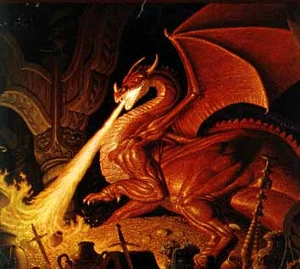
Dragons are very popular antagonists in folklore, mythology and fairy tales - though it is worth noting this tends to only apply to Western cultures, as other cultures (such as China) had a more positive view of dragons (which, in time, also spread to the West).
Dragons were originally depicted as giant fire-breathing snakes, often with wings and they would stand as the ultimate opponent to a brave knight or ancient hero - one of the most famous examples of this type of story was Saint Goerge and The Dragon: in which the brave knight went forth to slay a fearsome dragon to save a princess from its terrible grasp, this story became so popular that it has inspired innumerable adaptations in film and literature.
Other examples of dragons as antagonists in fairy tales can be found in stories such as Sleeping Beauty, in which the evil fairy transforms herself into a gigantic dragon (a scene made famous by Disney in their adaptation of the fairy tale - in which Maleficent's final form is a large, black dragon).
Sometimes a dragon was not a winged reptile but rather a gigantic snake, known as a "Wyrm" - these dragons were said to live in water or in wells and they often grew so large that brave heroes were called upon to slay them and save livestock or people from their often immense appetites.
As with many characters in folklore dragons may of been symbolic, a way of expressing how brave a hero was by having them defeat a seemingly unconquerable foe (in a similiar fashion as Giants were often used to symbolise the defeat of bigger enemies, such as military powers or invaders).
Dragons have also been given a malevolent role in the scripture of many religions - especially Christianity, due to their serpentine nature, they are often associated with the Devil and indeed one of the many forms given to the Devil is that of a dragon: he is also said to take the form of a large serpent (as he had done in the Garden of Eden).
In recent times however dragons have become more varied, with some heroic and noble dragons appearing (such as Spyro from the titular videogame series or Draco from Dragonheart) and some malevolent dragons appearing (such as Malefor).
Many fairy tales and legends also have dragons acting as guardians of large treasures or mystical items, making them popular opponents in fantasy games where heroes have to defeat one or more dragons in order to obtain the items it has been guarding, some stories take the role of guardian even further and have dragons acting as guardians of nature itself.
There are stories, however, where dragons are merely wild animals struggling to survive.
Depends on their physical appearance, dragons can be divided into following groups:
- Western Dragons typically depicted as a huge fire-breathing, scaly and horned lizard-like creature, with leathery, bat-like wings, with four legs and a long muscular tail. It is sometimes shown with feathered wings, crests, fiery manes, ivory spikes running down its spine and various exotic colorations. Dragon's blood often has magical properties. The typical dragon protects a cavern or castle filled with gold and treasure and is often associated with a great hero who tries to slay it. Though a winged creature, the dragon is generally to be found in its underground lair, a cave that identifies it as an ancient creature of earth.
- Asian Dragons typically portrayed as long, scaled, serpentine creatures with four legs. Traditionally they symbolize potent and auspicious powers, particularly control over water, rainfall, hurricane, and floods, and are also a symbols of power, strength, and good luck. They have also extended range of supernatural powers, chancing size or form (most are able to take human shape), fly among the clouds or hide in water, form clouds, turn into water, change color as an ability to blend in with their surroundings as an effective form of camouflage or glow in the dark.
- Lesser Drakes is something of a catch-all category, including the lesser dragon-like beings, such as wyvern, worm/wyrm, lindworm, etc., which are generally smaller and more animal-like in mind and behavior. However, this not always the case in fiction as sometimes they possesses equal capabilities with western dragons. The most famous types of all lesser drake is wyvern, whom often portrayed with powers of typical western dragons.
